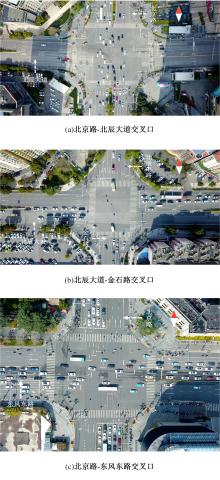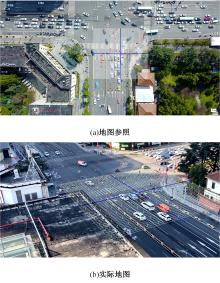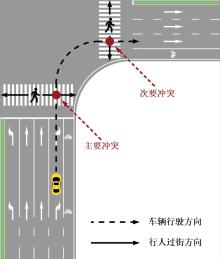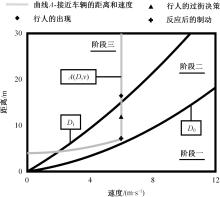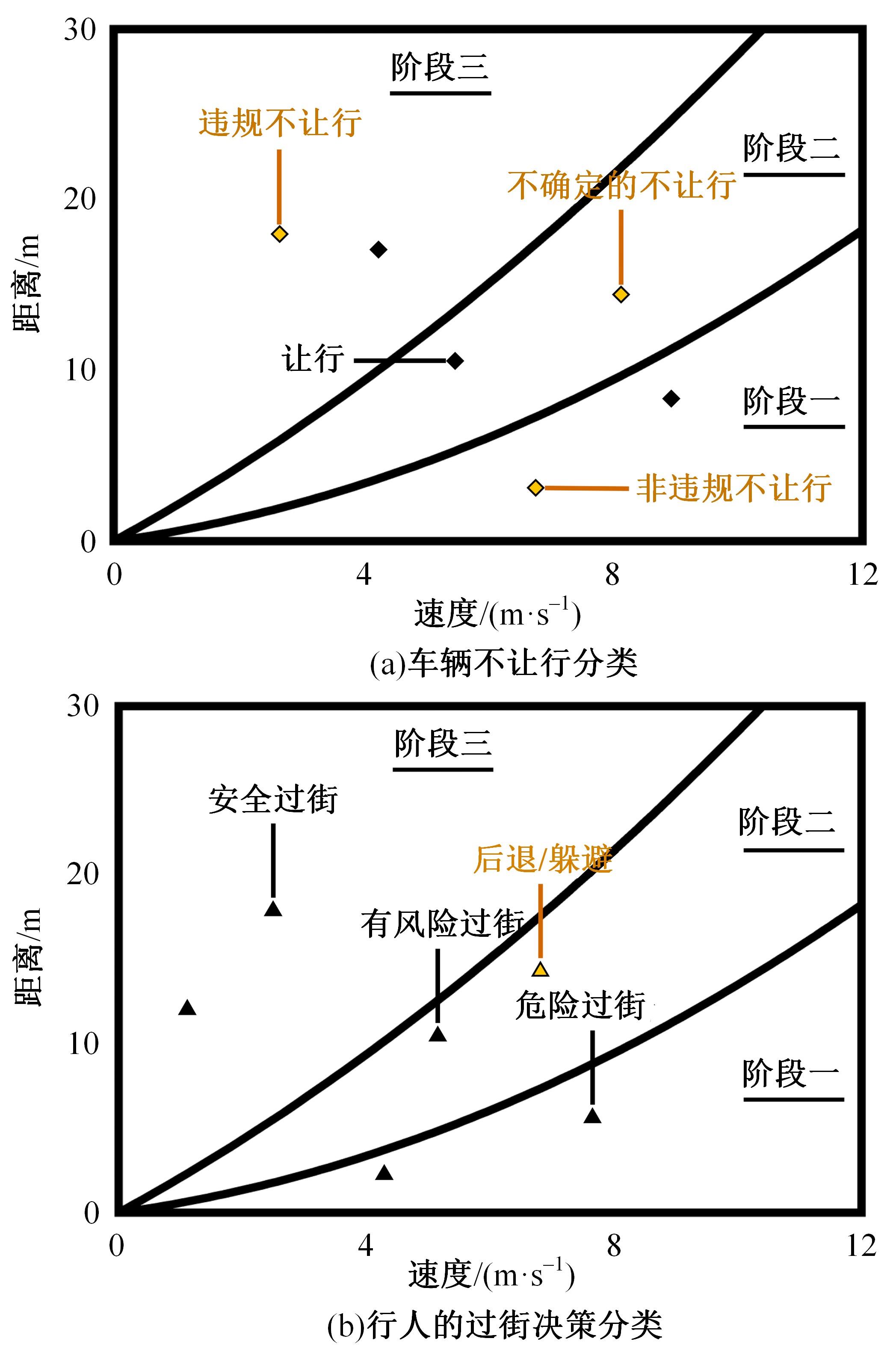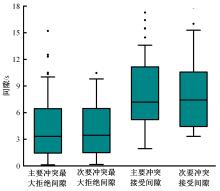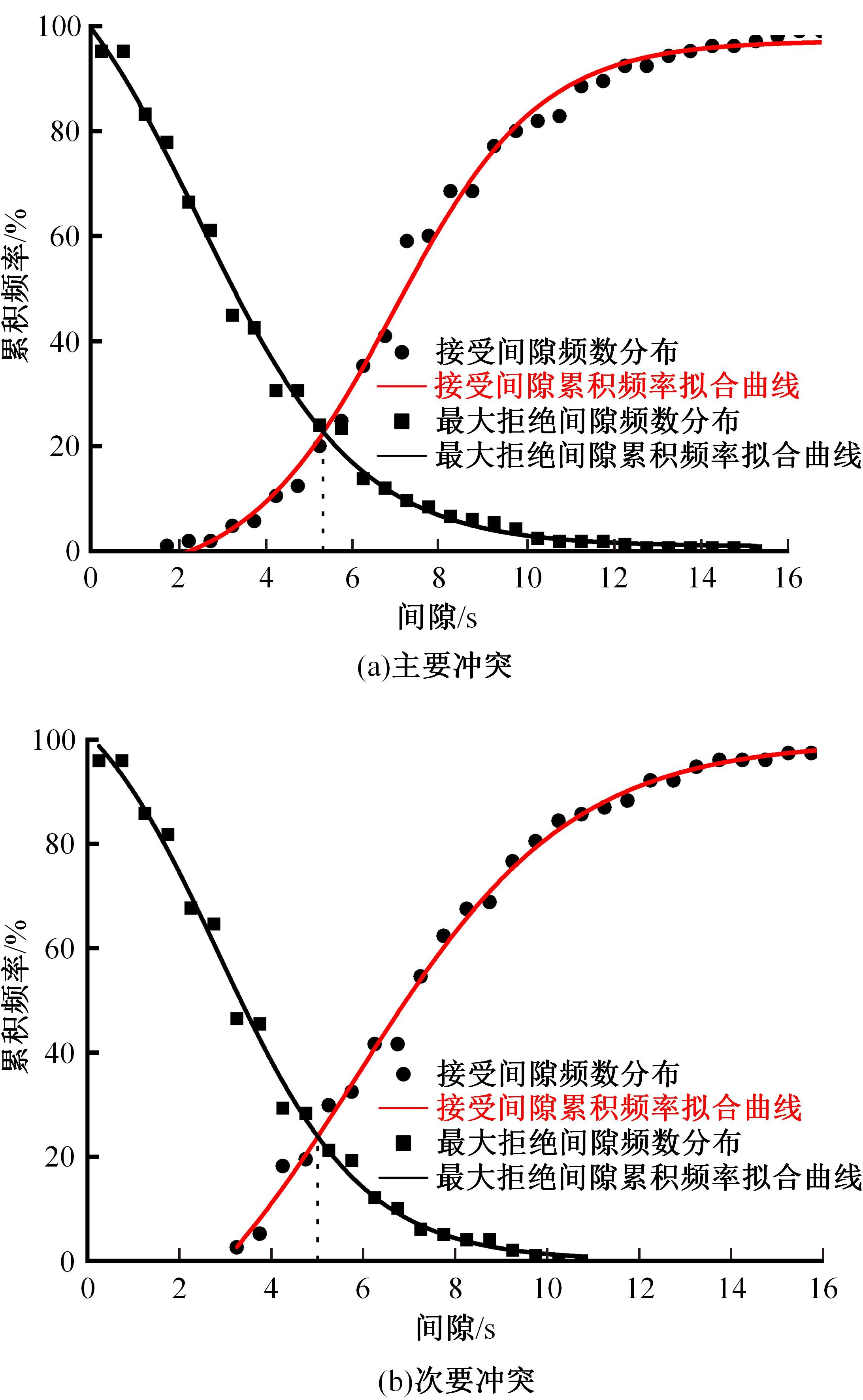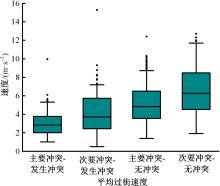Journal of Jilin University(Engineering and Technology Edition) ›› 2024, Vol. 54 ›› Issue (7): 1903-1912.doi: 10.13229/j.cnki.jdxbgxb.20221108
Safety evaluation method for pedestrians crossing street at signalized intersection considering secondary conflict of right-turn vehicles
Guo-zhu CHENG1( ),Lin SHENG1,Hao-yu WANG1,Tian-jun FENG2
),Lin SHENG1,Hao-yu WANG1,Tian-jun FENG2
- 1.School of Traffic and Transportation,Northeast Forestry University,Harbin 150040,China
2.School of Transportation Science and Engineering,Jilin University of Architecture,Changchun 130118,China
CLC Number:
- U491.7
| 1 | Zhu D, Sze N N, Bai L. Roles of personal and environmental factors in the red light running propensity of pedestrian: case study at the urban crosswalks[J]. Transportation Research Part F: Traffic Psychology and Behaviour, 2021, 76: 47-58. |
| 2 | World Health Organization. Global status report on road safety 2018: summary[R]. Geneva:World Health Organization, 2018. |
| 3 | Fu T, Hu W, Miranda-Moreno L, et al. Investigating secondary pedestrian-vehicle interactions at non-signalized intersections using vision-based trajectory data[J]. Transportation Research Part C: Emerging Technologies, 2019, 105: 222-240. |
| 4 | 程国柱, 盛林, 赵浩, 等. 基于危险度分析的信号交叉口专用相位设置条件[J]. 吉林大学学报: 工学版,2023, 53(7): 1962-1969. |
| Cheng Guo-zhu, Sheng Lin, Zhao Hao, et al. Exclusive phase setting condition of signalized intersection based on risk analysis[J]. Journal of Jilin University (Engineering and Technology Edition), 2023, 53(7):1962-1969. | |
| 5 | Jackson S, Miranda-Moreno L F, St-Aubin P, et al. Flexible, mobile video camera system and open source video analysis software for road safety and behavioral analysis[J]. Transportation Research Record, 2013, 2365(1): 90-98. |
| 6 | St-Aubin P, Saunier N, Miranda-Moreno L. Large-scale automated proactive road safety analysis using video data[J]. Transportation Research Part C: Emerging Technologies, 2015, 58: 363-379. |
| 7 | Laureshyn A, De Ceunynck T, Karlsson C, et al. In search of the severity dimension of traffic events: extended Delta-V as a traffic conflict indicator[J]. Accident Analysis & Prevention, 2017, 98:46-56. |
| 8 | Fu T, Miranda-Moreno L, Saunier N. A novel framework to evaluate pedestrian safety at non-signalized locations[J]. Accident Analysis & Prevention, 2018, 111: 23-33. |
| 9 | Jiang C, Qiu R, Fu T, et al. Impact of right-turn channelization on pedestrian safety at signalized intersections[J]. Accident Analysis & Prevention, 2020, 136: No.105399. |
| 10 | Wei D, Xu H, Kumfer W, et al. Vehicular traffic capacity at unsignalized crosswalks with probabilistic yielding behavior[J]. Transportation Research Record, 2015, 2483(1): 80-90. |
| 11 | Zhang C, Zhou B, Qiu T Z, et al. Pedestrian crossing behaviors at uncontrolled multi-lane mid-block crosswalks in developing world[J]. Journal of Safety Research, 2018, 64: 145-154. |
| 12 | 中华人民共和国全国人民代表大会常务委员会. 中华人民共和国道路交通安全法[J]. 中华人民共和国全国人民代表大会常务委员会公报, 2008(1): 32-45. |
| The Standing Committee of the National People's Congress of the People's Republic of China. Road traffic safety law of the People's Republic of China[J]. Gazette of the Standing Committee of the National People's Congress of the People's Republic of China, 2008(1): 32-45. | |
| 13 | Zhang Y, Fricker J D. Incorporating conflict risks in pedestrian-motorist interactions: a game theoretical approach[J]. Accident Analysis & Prevention, 2021, 159: No. 106254. |
| 14 | Shaon M R R, Schneider R J, Qin X, et al. Exploration of pedestrian assertiveness and its association with driver yielding behavior at uncontrolled crosswalks[J]. Transportation Research Record, 2018, 2672(35): 69-78. |
| 15 | Wang Y, Su Q, Wang C, et al. Investigating yielding behavior of heterogeneous vehicles at a semi-controlled crosswalk[J]. Accident Analysis & Prevention, 2021, 161: No.106381. |
| 16 | Zhang Y, Fricker J D. Multi-state semi-Markov modeling of recurrent events: estimating driver waiting time at semi-controlled crosswalks[J]. Analytic Methods in Accident Research, 2020, 28: No.100131. |
| 17 | Sołowczuk A, Kacprzak D. Identification of the determinants of the effectiveness of on-road chicanes in transition zones to villages subject to a 70 km/h speed limit[J]. Energies, 2020, 13(20): No.5244. |
| 18 | Varhelyi A. Drivers' speed behaviour at a zebra crossing: a case study[J]. Accident Analysis & Prevention, 1998, 30(6): 731-743. |
| 19 | Zhang C, Zhou B, Chen G, et al. Quantitative analysis of pedestrian safety at uncontrolled multi-lane mid-block crosswalks in China[J]. Accident Analysis & Prevention, 2017, 108: 19-26. |
| 20 | Transportation Research Board. Highway Capacity Manual[M]. Washington DC: National Research Council,2010. |
| 21 | Pawar D S, Patil G R. Critical gap estimation for pedestrians at uncontrolled mid-block crossings on high-speed arterials[J]. Safety Science, 2016, 86: 295-303. |
| 22 | 马万经, 叶新晨, 廖大彬, 等. 停车让行交叉口机动车接受间隙和拒绝间隙分布特征[J]. 中国公路学报, 2015, 28(4): 86-93. |
| Ma Wan-jing, Ye Xin-chen, Liao Da-bin, et al. Distribution characteristics of accepted gap and rejected gap for vehicles crossing stop-controlled intersections[J]. China Journal of Highway and Transport, 2015, 28(4): 86-93. | |
| 23 | Brilon W, Koenig R, Troutbeck R J. Useful estimation procedures for critical gaps[J]. Transportation Research Part A: Policy and Practice, 1999, 33(3/4): 161-186. |
| [1] | Yun PU,Yin XU,Hai-xu LIU,Yi-fan TAN. An improved car⁃following model for connected and automated vehicles considering impact of multiple vehicles [J]. Journal of Jilin University(Engineering and Technology Edition), 2024, 54(5): 1285-1292. |
| [2] | Ming-ye ZHANG,Min YANG,Yu LI,Shi-yu HUANG,Qing-yun LI. Optimal electric bus scheduling with multiple vehicle types considering coordinated recharging strategy [J]. Journal of Jilin University(Engineering and Technology Edition), 2024, 54(5): 1293-1301. |
| [3] | Da-yi QU,Ke-kun ZHANG,Yuan GU,Tao WANG,Hui SONG,Shou-chen DAI. Analysis of lane⁃changing decision⁃making behavior and molecular dynamics modeling for autonomous vehicles [J]. Journal of Jilin University(Engineering and Technology Edition), 2024, 54(3): 700-710. |
| [4] | Zhi ZHENG,Pei YUAN,Xuan-hui JIN,Si-si WEI,Bo GENG. Experimental on composite flexible anti⁃collision fender of bridge pier [J]. Journal of Jilin University(Engineering and Technology Edition), 2023, 53(9): 2581-2590. |
| [5] | Guo-zhu CHENG,Lin SHENG,Hao ZHAO,Tian-jun FENG. Exclusive phase setting condition of signalized intersection based on risk analysis [J]. Journal of Jilin University(Engineering and Technology Edition), 2023, 53(7): 1962-1969. |
| [6] | Yong-ming HE,Shi-sheng CHEN,Jia FENG,Ya-nan WAN. Superhighway virtual track system based on high precision map [J]. Journal of Jilin University(Engineering and Technology Edition), 2023, 53(7): 2016-2028. |
| [7] | Zhi-jia XUE,Zhao-yang WANG,Jiu-peng ZHANG,Chang-gen YAN,Zi-kai XU,Ying-li ZHANG,Xiao-ming Huang,Tao Ma. Toughness analysis and improvement of road structure under action of debris flow [J]. Journal of Jilin University(Engineering and Technology Edition), 2023, 53(6): 1773-1781. |
| [8] | Rong-han YAO,Wen-tao XU,Wei-wei GUO. Drivers' takeover behavior and intention recognition based on factor and long short⁃term memory [J]. Journal of Jilin University(Engineering and Technology Edition), 2023, 53(3): 758-771. |
| [9] | Xue XIAO,Ke-ping LI,Bo PENG,Man-wei CHANG. Integrated lane⁃changing model of decision making and motion planning for autonomous vehicles [J]. Journal of Jilin University(Engineering and Technology Edition), 2023, 53(3): 746-757. |
| [10] | Min MA,Da-wei HU,Lan SHU,Zhuang-lin MA. Resilience assessment and recovery strategy on urban rail transit network [J]. Journal of Jilin University(Engineering and Technology Edition), 2023, 53(2): 396-404. |
| [11] | Jing WANG,Feng WAN,Chun-jiao DONG,Chun-fu SHAO. Modelling on catchment area and attraction intensity of urban rail transit stations [J]. Journal of Jilin University(Engineering and Technology Edition), 2023, 53(2): 439-447. |
| [12] | Zhi-fa YANG,Bo SUN,Xian-jun FAN,Wen-cai SUN,Jing-jing TIAN,Ning SUN. Simulation on energy consumption of truck fleet on expressway under background of vehicle⁃infrastructure cooperative environment [J]. Journal of Jilin University(Engineering and Technology Edition), 2023, 53(12): 3452-3457. |
| [13] | Jian-cheng WENG,Rui-cong WEI,Han-mei HE,Hai-hui XU,Jing-jing WANG. Urban road network short-term traffic flow prediction model based on associated road chain group [J]. Journal of Jilin University(Engineering and Technology Edition), 2023, 53(11): 3104-3112. |
| [14] | Wei-chao ZHUANG,Hao-nan Ding,Hao-xuan DONG,Guo-dong YIN,Xi WANG,Chao-bin ZHOU,Li-wei XU. Learning based eco⁃driving strategy of connected electric vehicle at signalized intersection [J]. Journal of Jilin University(Engineering and Technology Edition), 2023, 53(1): 82-93. |
| [15] | Song FANG,Jian-xiao MA,Gen LI,Ling-hong SHEN,Chu-bo XU. Traffic risk analysis of moving work zone on right lane of city expressway [J]. Journal of Jilin University(Engineering and Technology Edition), 2022, 52(8): 1786-1791. |
|
||
